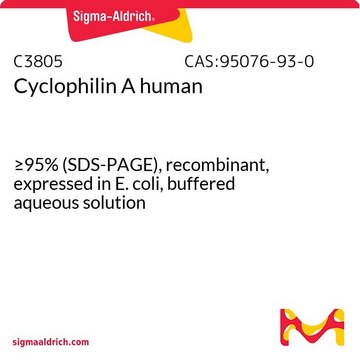SRP6091
FKBP1a/FKBP12 human
recombinant, expressed in E. coli, ≥95% (SDS-PAGE)
Sinonimo/i:
12 kDa FK506-binding protein, Calstabin-1, FK506 binding protein 1a, Immunophilin FKBP12, PPIase FKBP1A
About This Item
Prodotti consigliati
Origine biologica
human
Ricombinante
expressed in E. coli
Saggio
≥95% (SDS-PAGE)
Stato
liquid
PM
14.1 kDa
Confezionamento
pkg of 100 μg
N° accesso NCBI
N° accesso UniProt
Condizioni di spedizione
dry ice
Temperatura di conservazione
−70°C
Informazioni sul gene
human ... FKBP1A(2280)
Descrizione generale
Azioni biochim/fisiol
Stato fisico
Nota sulla preparazione
Altre note
Codice della classe di stoccaggio
11 - Combustible Solids
Classe di pericolosità dell'acqua (WGK)
WGK 3
Punto d’infiammabilità (°F)
Not applicable
Punto d’infiammabilità (°C)
Not applicable
Scegli una delle versioni più recenti:
Certificati d'analisi (COA)
It looks like we've run into a problem, but you can still download Certificates of Analysis from our Documenti section.
Se ti serve aiuto, non esitare a contattarci Servizio Clienti
Possiedi già questo prodotto?
I documenti relativi ai prodotti acquistati recentemente sono disponibili nell’Archivio dei documenti.
Il team dei nostri ricercatori vanta grande esperienza in tutte le aree della ricerca quali Life Science, scienza dei materiali, sintesi chimica, cromatografia, discipline analitiche, ecc..
Contatta l'Assistenza Tecnica.








